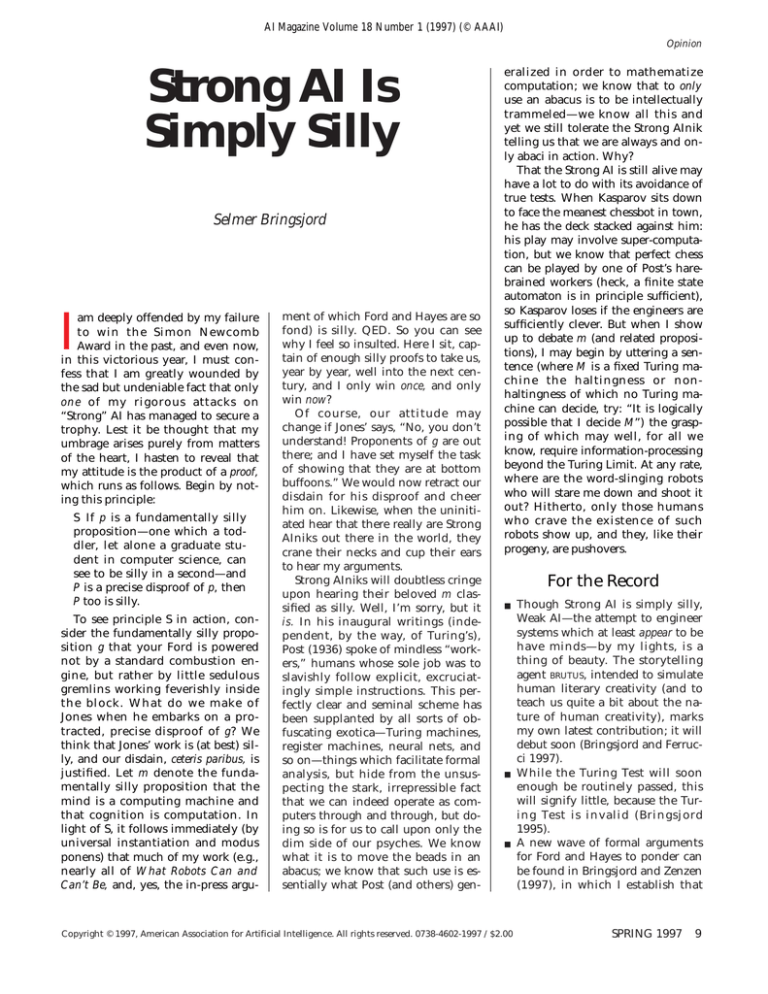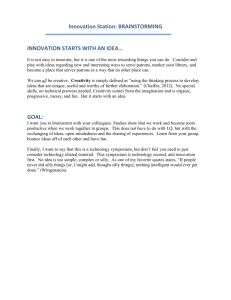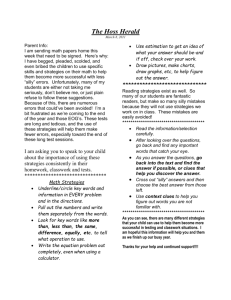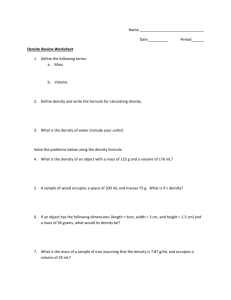
AI Magazine Volume 18 Number 1 (1997) (© AAAI)
Opinion
Strong AI Is
Simply Silly
Selmer Bringsjord
I
am deeply offended by my failure
to win the Simon Newcomb
Award in the past, and even now,
in this victorious year, I must confess that I am greatly wounded by
the sad but undeniable fact that only
one of my rigorous attacks on
“Strong” AI has managed to secure a
trophy. Lest it be thought that my
umbrage arises purely from matters
of the heart, I hasten to reveal that
my attitude is the product of a proof,
which runs as follows. Begin by noting this principle:
S If p is a fundamentally silly
proposition—one which a toddler, let alone a graduate student in computer science, can
see to be silly in a second—and
P is a precise disproof of p, then
P too is silly.
To see principle S in action, consider the fundamentally silly proposition g that your Ford is powered
not by a standard combustion engine, but rather by little sedulous
gremlins working feverishly inside
the block. What do we make of
Jones when he embarks on a protracted, precise disproof of g? We
think that Jones’ work is (at best) silly, and our disdain, ceteris paribus, is
justified. Let m denote the fundamentally silly proposition that the
mind is a computing machine and
that cognition is computation. In
light of S, it follows immediately (by
universal instantiation and modus
ponens) that much of my work (e.g.,
nearly all of What Robots Can and
Can’t Be, and, yes, the in-press argu-
ment of which Ford and Hayes are so
fond) is silly. QED. So you can see
why I feel so insulted. Here I sit, captain of enough silly proofs to take us,
year by year, well into the next century, and I only win once, and only
win now?
Of course, our attitude may
change if Jones’ says, “No, you don’t
understand! Proponents of g are out
there; and I have set myself the task
of showing that they are at bottom
buffoons.” We would now retract our
disdain for his disproof and cheer
him on. Likewise, when the uninitiated hear that there really are Strong
AIniks out there in the world, they
crane their necks and cup their ears
to hear my arguments.
Strong AIniks will doubtless cringe
upon hearing their beloved m classified as silly. Well, I’m sorry, but it
is. In his inaugural writings (independent, by the way, of Turing’s),
Post (1936) spoke of mindless “workers,” humans whose sole job was to
slavishly follow explicit, excruciatingly simple instructions. This perfectly clear and seminal scheme has
been supplanted by all sorts of obfuscating exotica—Turing machines,
register machines, neural nets, and
so on—things which facilitate formal
analysis, but hide from the unsuspecting the stark, irrepressible fact
that we can indeed operate as computers through and through, but doing so is for us to call upon only the
dim side of our psyches. We know
what it is to move the beads in an
abacus; we know that such use is essentially what Post (and others) gen-
eralized in order to mathematize
computation; we know that to only
use an abacus is to be intellectually
trammeled—we know all this and
yet we still tolerate the Strong AInik
telling us that we are always and only abaci in action. Why?
That the Strong AI is still alive may
have a lot to do with its avoidance of
true tests. When Kasparov sits down
to face the meanest chessbot in town,
he has the deck stacked against him:
his play may involve super-computation, but we know that perfect chess
can be played by one of Post’s harebrained workers (heck, a finite state
automaton is in principle sufficient),
so Kasparov loses if the engineers are
sufficiently clever. But when I show
up to debate m (and related propositions), I may begin by uttering a sentence (where M is a fixed Turing machine the haltingness or nonhaltingness of which no Turing machine can decide, try: “It is logically
possible that I decide M”) the grasping of which may well, for all we
know, require information-processing
beyond the Turing Limit. At any rate,
where are the word-slinging robots
who will stare me down and shoot it
out? Hitherto, only those humans
who crave the existence of such
robots show up, and they, like their
progeny, are pushovers.
For the Record
■
■
■
Copyright © 1997, American Association for Artificial Intelligence. All rights reserved. 0738-4602-1997 / $2.00
Though Strong AI is simply silly,
Weak AI—the attempt to engineer
systems which at least appear to be
have minds—by my lights, is a
thing of beauty. The storytelling
agent BRUTUS, intended to simulate
human literary creativity (and to
teach us quite a bit about the nature of human creativity), marks
my own latest contribution; it will
debut soon (Bringsjord and Ferrucci 1997).
While the Turing Test will soon
enough be routinely passed, this
will signify little, because the Turing Test is invalid (Bringsjord
1995).
A new wave of formal arguments
for Ford and Hayes to ponder can
be found in Bringsjord and Zenzen
(1997), in which I establish that
SPRING 1997
9
Opinion
■
we are (relative to mere computation) super-minds. (So that readers
really get their money’s worth, I
also refute Church’s Thesis.) Early
versions of some of these arguments can be found on my web
site.
For the ultimate in silliness, we
can turn to what might be called
‘Strong Sub-symbolic AI.’ This
view inherits all the idiocy of
Strong AI simpiciter, because neural
nets—at least ones that aren’t analog and chaotic—are really just cellular automata, which are really
just k-tape Turing machines,
which are really just abaci, which
takes up back to the silly notion
that we don’t only use abaci, we
are abaci. But the sub-symbolic
view adds insult to injury: it adds
the impenetrability of neural nets.
After all, what do we learn from
PET scans about how, say, human
detectives work? Zilch. Likewise,
what would we learn by inspecting
the innards of a connectionist system able to solve mysteries?
Hayes and Ford Reply
to Bringsjord
P
rofessor Bringsjord is the only
person to have nominated himself for our Award, and we
thank him for this time-saving courtesy. He may be right to take us to
task for his not having received an
Award earlier. When faced with such
a barrage of stuff, it is sometimes
hard to discern the trees in the forest. In future, we will consider his arguments more carefully and take care
to give them the consideration they
deserve. However, his work does suggest the possibility that the rules
committee may find it necessary to
limit the number of times a single
person can be given the award.
The argument sketched in his let-
ter is not original enough, we feel.
The idea that if we were computers
life would seem to be indescribably
tedious, since all computers are basically just abaci, reflects a distressingly familiar confusion between phenomenology and recursion theory.
However, his forthcoming refutation
of Church’s Thesis seems likely to be
a promising candidate for a Simon
Newcomb Award, and we look forward to it with interest.
– Patrick Hayes & Kenneth Ford
University of West Florida
Bibliography
Bringsjord, S. 1997. An Argument for the
Uncomputability of Infinitary Mathematical Expertise. In Expertise in Context,
eds. P. Feltovich, K. Ford, and R. Hoffman.
Forthcoming.
Bringsjord, S. 1995. Could, How Could
We Tell If, and Why Should—Androids
Have Inner Lives. In Android Epistemology,
eds. Ken Ford, Clark Glymour, and Pat
Hayes, 93–122. Cambridge, Mass.: MIT
Press.
Bringsjord, S. 1992. What Robots Can and
Can’t Be. Dordrecht, The Netherlands:
Kluwer.
Bringsjord, S., and Ferrucci, D. 1997. Artificial Intelligence, Literary Creativity, and
Story Generation: The State of the Art. Hillsdale, N.J.: Lawrence Erlbaum.
Bringsjord, S., and Zenzen, M. 1997. Super-Minds: A Defense of Uncomputable
Cognition. Dordrecht, The Netherlands:
Kluwer. Forthcoming.
Post, E. L. 1936. Finite Combinatory Processes—Formulation 1. Journal of Symbolic
Logic 1(3): 103–105.
10
AI MAGAZINE
AI Magazine Errata
Sridhar Mahadevan noticed two incorrect references in his report “The
National Science Foundation Workshop on Reinforcement Learning”
(by Sridhar Mahadevan and Leslie Pack Kaelbling, AI Magazine 17(4):
89-97.) In one of the references, the author’s names were reversed (Russell and Parr should be Parr and Russell). In the other reference some
coauthors were unintentially omitted. The corrected references are:
Boutilier, C.; Dearden, R.; and Goldszmidt, M. 1995. Exploiting Structure in Policy Construction. In Proceedings of the Fourteenth International Joint Conference on Artificial Intelligence, 1104-1111. Menlo
Park, Calif.: International Joint Conferences on Artificial Intelligence.
Parr, R., and Russell, S. 1995. Approximating Optimal Policies for Partially Observable Stochastic Domains. In Proceedings of the Fourteenth
International Joint Conference on Artificial Intelligence, 1088-1094.
Menlo Park, Calif.: International Joint Conferences on Artificial Intelligence.







